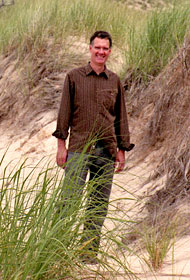
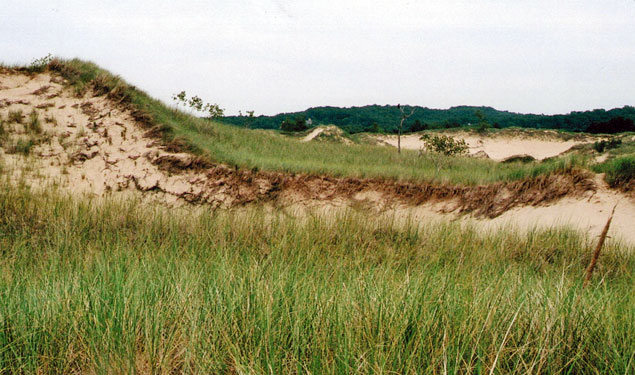
Photograph © Michael Carroll Mettler
Life, nature, and art exist in a careful balance. Notions of what is precious and precarious often lie side by side—every now and then they converge in something memorable and celebratory as in the Saugatuck Dunes. — Joseph Antenucci Bercherer
History of Saugatuck Dunes
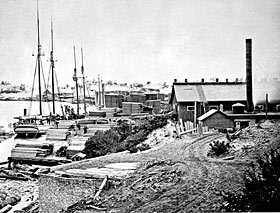
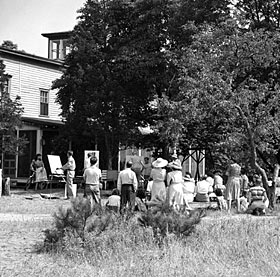
(upper) The now buried town of Singapore in 1869;
(lower)
The Ox-Bow Summer School of Art, circa 1950.
Images courtesy Saugatuck Douglas Historical Society.
Native Americans settled the dunes along the shores of Lake Michigan and the Kalamazoo River, building birch bark canoes and trading from the prime location. Early European traders and, later, American lumbermen moved to the area, establishing year-round settlements in the 1830s that would become the towns of Saugatuck and Douglas. Writer James Fennimore Cooper was one such settler and would later immortalize his experience with the Native Americans in his book Oak Openings (1848). Mills were set up to process the region’s harvested lumber, but, by 1880, clear-cutting decimated the abundant timberlands.
In the late 19th century, the area also became an attraction for Chicagoans. In 1898, social reformer Reverend George Gray established his “Chautauqua for the Poor Forward Movement Camp” in the region. The 100-plus acre camp under the auspices of the Presbytery of Chicago continues to provide generations of inner-city children the opportunity to experience the dunes. The Ox-Bow Summer School of Art, established at the turn of the century, operates as the oldest summer school of painting in the country. The school helped usher in the American era of plein air painting, which focused on painting outdoors, as opposed to in a studio, and encouraged collectors and benefactors to visit the region.
At the same time, a group of Chicagoans began work to reclaim the region’s deforested land and helped launch a successful fruit industry in order to promote more sustainable local agricultural practices. With the economy stabilizing and the recreational offerings growing, a large influx of summer cottages and tourists came to the area. The beaches and dunes attracted summer visitors from all over the Midwest.
Today, a thousand acres of protected open space in the Saugatuck Dunes State Park, over 20 art galleries and working artist studios, churches of all faiths, and a diverse collection of historic architectural styles, reflect the area’s many layers of settlement. The buildings from the former milling town of Singapore that could be salvaged were moved into town, where a handful still stand, but the bank and graves of the early settlers rest where they were buried at the last undeveloped harbor mouth on Lake Michigan. In 2009, the National Trust for Historic Preservation named Saugatuck and the nearby town of Douglas to its annual list of America's Dozen Distinctive Destinations and, in 2010, reiterated its significant by naming it to their annual list of 11 Most Endangered Historic Places.
The Saugatuck Douglas Dunes Coastal Area lies within three different governmental jurisdictions: the City of Saugatuck, the Village of Douglas, and Saugatuck Township. Each of these entities has developed planning and zoning regulations that have, at times, been at odds. However, the agencies worked together to develop the Tri-Community Comprehensive Plan, which, among other things, established land-use goals. The plan recognized that open space was a significant economic driver of the local tourist economy and proposed the creation of a park along the lakefront that would link the Saugatuck Dunes State Park with Oval Beach and the Presbyterian Camps to the south.
Spurred by an ultimately unsuccessful proposal to install a water treatment plant in the state park, David Swan has worked for more than a decade to preserve the natural and cultural resources of the dunes. In 2006, he led a group of local organizations in an effort to support the implementation of the updated Tri-Community Master Plan, concurrently working with public officials and private citizens to enforce local zoning ordinances. The coalition of groups and hundreds of interested citizens formed the nonprofit Saugatuck Dunes Coastal Alliance in 2007.
Since that time, Mr. Swan has directed scientists from around the state in the development of a comprehensive inventory of flora and fauna throughout the area and worked with a cartographer to map out the critical dune areas. This information has been invaluable to better understanding the impact of potential development in the area as well as providing the public with a better understanding of the site’s natural resources. The efforts have also served to engage the media, citizens, and officials. As the current President of the Saugatuck Dunes Coastal Alliance, Mr. Swan has advocated for funding more research and land acquisition of key resources in the region. He continues to tirelessly advocate for implementation of locally-determined zoning rules that serve to protect the dunes’ resources.
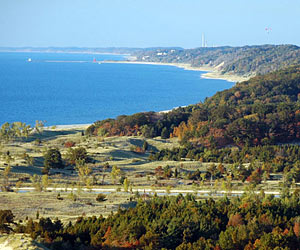
Photograph by Erin Wilkinson
Threat
In 2000, a key 400-acre lakefront parcel came up for sale and State and local officials and business leaders, working in concert with the Conservation Fund, the Land Conservancy of West Michigan, and the Nature Conservancy, began negotiations to purchase the land. A private developer, however, purchased the culturally and environmentally significant property and has proposed extensive plans that challenge existing zoning and permit regulations meant to guide development of the dunes.
